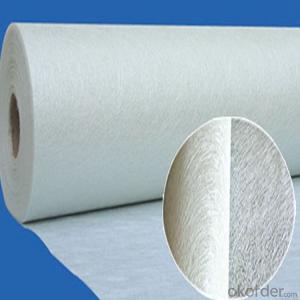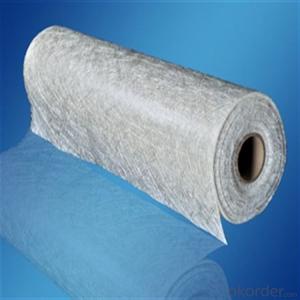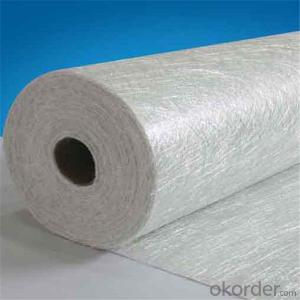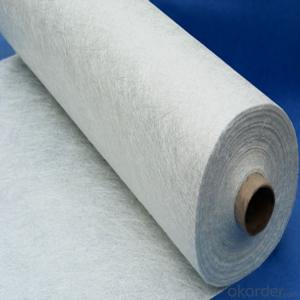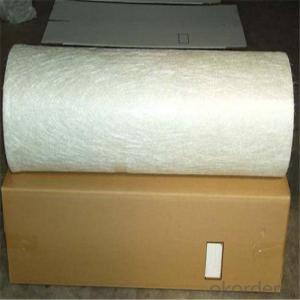Fiberglass Chopped Strands Chopped Strand Mat E-Glass & C-Glass Fiberglass
- Loading Port:
- China main port
- Payment Terms:
- TT OR LC
- Min Order Qty:
- 1 kg
- Supply Capability:
- 5000 kg/month
OKorder Service Pledge
OKorder Financial Service
You Might Also Like

Product Description:
Chopped strand mat is made from chopped glass fibers, which are bonded with powder or emulsion binders. It can be used in hand lay-up process and continuous laminating process to produce FRP products, such as plates, lighting board, hull, bathtub, cooling towers, anti-corrosion materials, vehicles.
Good transparency for the laminates
Rapid wet out
Easy to remove air bubbles
Good dispersion and uniformity
High wet-strength retention
Good mechanical properties
Specifications:
Item | Over Density | Moisture Content | Chop Density | Polyester Yarn | Width |
(g/m2) | (%) | (g/m2) | (g/m2) | (mm) | |
EMK300 | 309.5 | ≤0.15 | 300 | 9.5 | 50-3300 |
EMK380 | 399 | 380 | 19 | ||
EMK450 | 459.5 | 450 | 9.5 | ||
EMK450 | 469 | 450 | 19 | ||
EMC0020 | 620.9 | 601.9 | 19 | ||
EMC0030 | 909.5 | 900 | 9.5 |
Special products are available according to customer’s requirement.
Product Packaging:
Each Surface Tissue is wound onto a paper tube which has an inside diameter of 76mm and the mat roll has a diameter of 330mm. The mat roll is wrapped up with plastic film,and then packed in a cardboard box or wrapped up with kraft paper. The rolls can be vertically or horizontally placed. For transportation, the rolls can be loaded into a cantainer directly or on pallets.
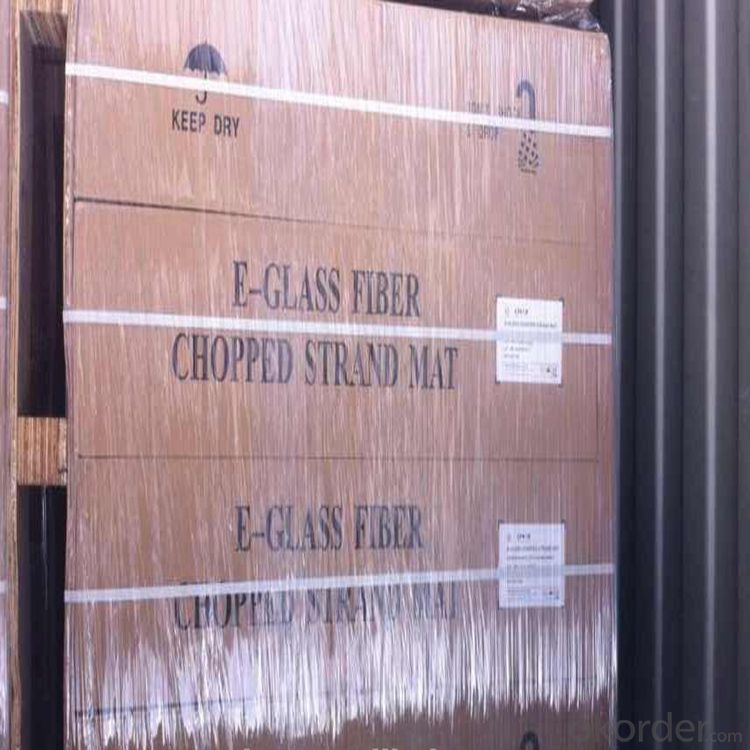
Product Storage:
Unless otherwise specified, Chopped Strand Mat should be stored in a dry, cool and rain-proof area. It is recommended that the room temperature and humidity should be always maintained at 15℃~35℃ and 50%~75% respectively.
Company Information
CNBM (China National Building Material) Group is the largest comprehensive building materials group in China that in integrate scientific research, manufacturing and logistics into one entity. The largest building materials and equipment specialists in China. Upon State Council approval, today CNBM owned more than 300 subordinate manufacturing factories and servicing companies. There are 6 fully owned public listed companies and 11 partially owned with substantial shares public listed companies. In many of these fields, CNBM is playing the leading role in the building industry in the country.

FAQ:
which kind of glass fiber sample and materials can you provide?
We can provide the glass fiber and glass fiber down stream products samples of E glass, C glass, ECR glass, High alkali glass. The products includes single end roving, assembled roving for different applications( Piping, SMC, panel, winding mill plate) , chop strand for BMC, engineering plastic (PA, PPA, PPT, POM, etc), chop strand mat (from 100gsm-900gsm) for automobile and water tank, etc, woven roving (270gsm-800gsm), surface tissue (25-50gsm), multi-axial fabric of different unit weight.
- Q: Can fiberglass chopped strand be used in the manufacturing of sports equipment?
- Sports equipment manufacturing can utilize fiberglass chopped strand, which is a versatile material offering numerous advantages. Firstly, its lightweight property enhances ease of use and maneuverability, making it ideal for tennis rackets, golf clubs, and hockey sticks. Secondly, its exceptional strength and durability enable the equipment to withstand the stress and impact it encounters during use, ensuring optimal performance over an extended period. Additionally, fiberglass chopped strand's corrosion-resistant nature safeguards against moisture and environmental factors, benefiting equipment exposed to water or harsh weather conditions like surfboards or kayaks. Moreover, its ability to be easily molded into various shapes and sizes allows for the customization of sports equipment, meeting the specific requirements of different sports and athletes. In conclusion, fiberglass chopped strand is a suitable material for sports equipment manufacturing, as it possesses lightweight, strength, durability, corrosion-resistance, and flexibility, enhancing performance and longevity, making it a popular choice in the industry.
- Q: How is the moisture resistance of fiberglass chopped strand composites tested?
- The moisture resistance of fiberglass chopped strand composites is typically tested through various methods such as immersion testing, humidity testing, and water absorption testing. 1. Immersion Testing: In this method, the fiberglass chopped strand composite samples are completely submerged in water for a specified period of time. The samples are then examined for any signs of delamination, weight gain, dimensional changes, or other visible damage caused by moisture absorption. This test helps to evaluate the composite's ability to resist moisture penetration over an extended period. 2. Humidity Testing: Humidity testing involves subjecting the fiberglass chopped strand composite samples to high humidity conditions for a specific period. The samples are placed in a controlled environment with elevated humidity levels, often around 95% relative humidity. The samples are then assessed for any changes in weight, appearance, or mechanical properties. This test helps to determine the composite's resistance to moisture in high humidity environments. 3. Water Absorption Testing: Water absorption testing measures the amount of water that a fiberglass chopped strand composite can absorb over time. This test is usually conducted by immersing the samples in water or exposing them to a high humidity environment for a set duration. After the exposure, the samples are weighed to determine the amount of water absorbed. This test helps to quantify the composite's susceptibility to moisture absorption, which can affect its mechanical properties and performance. These testing methods allow manufacturers, engineers, and researchers to assess the moisture resistance of fiberglass chopped strand composites and ensure they meet specific industry standards, customer requirements, and intended applications. By evaluating the composite's ability to resist moisture penetration, these tests help to ensure the durability, reliability, and longevity of the product in various environmental conditions.
- Q: Can fiberglass chopped strand be used for structural reinforcement?
- Yes, fiberglass chopped strand can be used for structural reinforcement. Fiberglass chopped strand refers to short lengths of fiberglass strands that are randomly chopped into small pieces. These chopped strands are commonly used in composite materials, such as fiberglass reinforced plastic (FRP), to provide strength and reinforcement. When used in structural applications, fiberglass chopped strand is typically combined with a matrix material, such as resin or concrete, to form a composite. The chopped strands are evenly dispersed within the matrix, creating a reinforced material with enhanced mechanical properties. The use of fiberglass chopped strand for structural reinforcement offers several advantages. Firstly, fiberglass is a lightweight material, which makes it easier to handle and transport compared to other traditional reinforcement materials like steel. Secondly, fiberglass has excellent tensile strength and stiffness properties, allowing it to effectively withstand and distribute loads in structural applications. Additionally, fiberglass is highly corrosion-resistant, making it suitable for use in environments with high moisture or chemical exposure. However, it is important to note that the effectiveness of fiberglass chopped strand as a structural reinforcement material depends on several factors, such as the design and engineering of the structure, the quality of the composite material, and the proper installation techniques. Therefore, it is advisable to consult with a professional engineer or specialist in composite materials to ensure the correct application of fiberglass chopped strand for structural reinforcement purposes.
- Q: Is fiberglass chopped strand suitable for insulation materials?
- Yes, fiberglass chopped strand is suitable for insulation materials. Fiberglass is a versatile material that is widely used for its excellent thermal insulation properties. Chopped strand fiberglass consists of small strands of glass fibers that are randomly chopped into short lengths. These chopped strands can be used to create insulation materials such as fiberglass blankets, batts, and boards. Fiberglass chopped strand insulation offers several benefits. Firstly, it has a low thermal conductivity, meaning it effectively reduces heat transfer. This helps to keep buildings warm in cold weather and cool in hot weather, leading to energy savings and increased comfort. Additionally, fiberglass insulation is non-combustible, making it safe to use in various applications. Moreover, fiberglass chopped strand insulation is lightweight and easy to handle, making it convenient for installation. It is also resistant to moisture, mold, and mildew, ensuring durability and longevity. Furthermore, fiberglass insulation is an environmentally friendly option as it is made from recycled materials and can be recycled at the end of its lifecycle. Overall, fiberglass chopped strand is an excellent choice for insulation materials due to its thermal insulation properties, safety features, ease of handling, and environmental sustainability.
- Q: Is fiberglass chopped strand suitable for the production of sports equipment?
- Yes, fiberglass chopped strand is suitable for the production of sports equipment. It offers excellent strength and durability, making it ideal for various applications in sports equipment manufacturing.
- Q: What's wrong with the fluff of the glass fiber after chopping?
- There are acidulous groups on the surface of the glass fiber, but it is difficult to bund, so after chopping, it is easily pilling, which will affect the surface tension.
- Q: Can fiberglass chopped strand be used in the production of bathroom fixtures?
- The production of bathroom fixtures can benefit from the use of fiberglass chopped strand. This reinforcing material is typically comprised of fine glass fibers that have been chopped into shorter lengths. It is commonly employed as a reinforcement in a variety of materials and products, including bathroom fixtures. Bathroom fixtures, such as bathtubs, shower trays, sinks, and toilet tanks, necessitate a resilient and robust material that can endure water, moisture, and regular usage. Fiberglass chopped strand is an excellent choice for fortifying these fixtures due to its impressive strength-to-weight ratio, resistance to corrosion, and ability to withstand water. To create a composite material for the production of bathroom fixtures, fiberglass chopped strand is usually combined with a resin matrix, such as polyester or acrylic. This composite material offers the necessary strength and durability required to withstand the demands of daily use in a bathroom setting. Furthermore, fiberglass chopped strand can be effortlessly molded into various shapes and sizes, allowing for the creation of customized and visually appealing bathroom fixtures. It can also be easily blended with other materials, such as gelcoats or colorants, to achieve desired surface finishes or colors. Overall, fiberglass chopped strand is a suitable and extensively utilized material in the production of bathroom fixtures due to its strength, durability, resistance to water, and versatility in design.
- Q: What are the typical manufacturing challenges when using fiberglass chopped strand composites?
- Several typical challenges may arise when utilizing fiberglass chopped strand composites in manufacturing. One of the challenges commonly encountered is the attainment of uniform fiber dispersion throughout the composite material. It is crucial to employ proper mechanical mixing and dispersing techniques to ensure even distribution of the chopped fiberglass strands within the matrix. Failure to achieve this can result in weak areas and diminished mechanical properties in the final product. Another challenge is the achievement of good wet-out between the resin matrix and the chopped strands. Each individual strand must be thoroughly wetted by the resin to ensure proper bonding and strength. Insufficient wet-out can lead to the formation of voids, delamination, and reduced overall performance of the composite. Controlling the length of the fibers is also a challenge. Chopped strand composites generally consist of short fibers, and maintaining consistent fiber length is critical for attaining desired mechanical properties. Variations in fiber length can cause inconsistencies in strength and stiffness, which affects the overall performance of the composite. Additionally, fiber alignment can present difficulties during the manufacturing process. Proper orientation and alignment of the chopped fibers within the matrix are vital for optimizing mechanical properties. Misalignment or random orientation of fibers can result in anisotropic properties and reduced overall strength. Lastly, challenges related to surface finish and appearance may arise. Chopped strand composites often exhibit a rough surface due to the presence of randomly oriented fibers. Achieving a smooth and aesthetically pleasing finish may necessitate additional processing steps, such as sanding or application of surface coatings. In conclusion, these challenges necessitate meticulous process control, optimization of mixing techniques, and implementation of quality control measures to ensure the successful utilization of fiberglass chopped strand composites in manufacturing.
- Q: Can fiberglass chopped strand be used in water treatment tanks?
- Yes, fiberglass chopped strand can be used in water treatment tanks. Fiberglass is resistant to corrosion and can withstand exposure to chemicals commonly found in water treatment processes. Additionally, it is lightweight, durable, and can be easily molded into various tank shapes and sizes.
- Q: How does the fiber-matrix interfacial shear strength distribution of fiberglass chopped strand affect the properties of composites?
- The fiber-matrix interfacial shear strength distribution of fiberglass chopped strand significantly affects the properties of composites. A strong interfacial shear strength enhances the bonding between the fiber and the matrix, leading to improved mechanical properties such as tensile strength, flexural strength, and impact resistance. It also helps to prevent fiber pull-out or debonding, which can weaken the composite material. Therefore, a higher interfacial shear strength distribution of fiberglass chopped strand results in enhanced overall performance and durability of composites.
Send your message to us
Fiberglass Chopped Strands Chopped Strand Mat E-Glass & C-Glass Fiberglass
- Loading Port:
- China main port
- Payment Terms:
- TT OR LC
- Min Order Qty:
- 1 kg
- Supply Capability:
- 5000 kg/month
OKorder Service Pledge
OKorder Financial Service
Similar products
Hot products
Hot Searches
Related keywords
